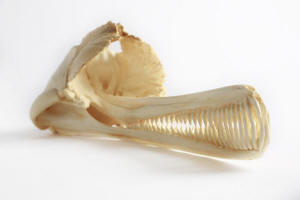Adaptation: Form and Function
Ganges river
dolphins are well adapted for movement throughout their aquatic
environment. They have a streamlined body with several fins to aid
in navigation and propulsion. The Ganges river dolphins have two
pectoral fins to steer with a very small dorsal fin on top that
actually resembles more of a hump or crest than an actual fin. Its
long flipper and wide fluke is what propels it forward through the
water. Like all dolphins, the fluke is oriented horizontally. Since
the Ganges River dolphin is a mammal it is restricted as a
fresh-air-breather and must surface in order for it to obtain the
necessary oxygen. They have developed high capacity lungs that allow
them to stay submerged for an average of 120 seconds and as much as
465 seconds. (Sinha et al.,
2010)
The heavily polluted and highly populated waters of the Ganges River create a very turbid aquatic environment where visibility is low. Like a lot of other dolphins and marine mammals, the Ganges river dolphins use their biosonar capabilities to navigate the water and locate potential prey or threats. Using series of signals, the dolphin is able to detect objects based on how long it takes for the sound to return back to them and also allows for communication between multiple dolphins. Their skull has a unique maxillary crest that is thought to aid in the directionality of their clicks. (Jensen et al., 2013) In fact, these dolphins have become so reliant on this adaptation; they no longer need eye sight to navigate. The two eyes it has are very small and are difficult to see and ultimately serve little funcion.
Although few in
numbers, the Ganges River dolphins are highly evolved and adapted
predators that are very well suited to their murky river habitat
because of the features they have derived. They are one of the top
predators in their ecosystem and help to regulate population of the
organisms they eat, mostly smaller fish and crustaceans. Their only
predator is us, humans, who hunt them for a variety of reasons
including for food, their oil which is used in medicine and for bait
by local fishermen. Unfortunately, the adaptations they have are
adapted for catching
prey quickly and efficiently, not so much to
avoid capture by humans or death by the pollutants in the rivers
they occupy.
habitat
because of the features they have derived. They are one of the top
predators in their ecosystem and help to regulate population of the
organisms they eat, mostly smaller fish and crustaceans. Their only
predator is us, humans, who hunt them for a variety of reasons
including for food, their oil which is used in medicine and for bait
by local fishermen. Unfortunately, the adaptations they have are
adapted for catching
prey quickly and efficiently, not so much to
avoid capture by humans or death by the pollutants in the rivers
they occupy.
Being able to
swim with the fish is only part of the battle; they also need to be
able to catch their prey that is also adapted to elude them. As a
result they have developed a long, toothed snout, mouth and jaw. Its
long snout helps to increase its reach and allow for more teeth, and
is narrow to get into small places to pull out the deepest of hiding
fish and crustaceans. The teeth are pointed and serrated to ensure
the dolphin holds on to its catch and is able to ingest it. They
also are one of the cetaceans with unfused vertebrae in their necks
allowing them to move their heads side to side.
 Figure
2. Size comparison of South Asian river dolphins to a swimming human
Figure
2. Size comparison of South Asian river dolphins to a swimming human
.jpg)